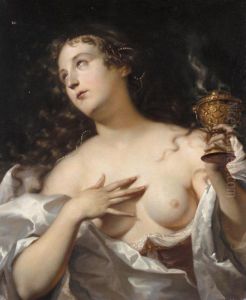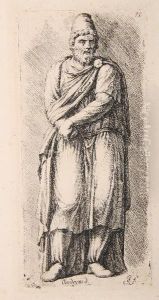Willem Doudijns Paintings
Willem Doudijns was a Dutch Golden Age painter, engraver, and draftsman known for his history paintings and his significant role in the art community of his time. He was born in The Hague, Netherlands, in 1630 into a family with artistic connections; his father was an art dealer and auctioneer. Doudijns received his early training in the studio of the painter and architect, Pieter Post. He further honed his skills during an extended study trip to Italy, a common practice among Dutch artists of the period, which greatly influenced his work.
In Italy, Doudijns was particularly inspired by the grandeur and dramatic style of the Roman Baroque, which he would later integrate into his own compositions. After spending around four years in Rome, he returned to The Hague in the mid-1650s, where he became an influential figure and helped establish the drawing academy in 1656, known as the Confrerie Pictura. This institution was crucial in the education of young artists and in promoting fine arts in the city, serving as an alternative to the traditional Guild of Saint Luke.
Doudijns' work often depicted historical and mythological scenes, characterized by their dynamic compositions, bold use of light and shadow, and classical influences. He was also known for his portraits and his ability to capture the likeness and character of his sitters. In addition to his painting, Doudijns was active as an art teacher, with notable pupils who would become significant artists themselves.
Throughout his career, Doudijns occupied various important positions within the Confrerie Pictura, including serving as its head. His leadership and vision were instrumental in fostering a vibrant artistic community in The Hague. He continued to work and teach until his death in 1697. Although not as widely recognized today as some of his contemporaries, Doudijns' contributions to Dutch art were substantial, particularly in the context of the artistic life of The Hague during the Dutch Golden Age.

